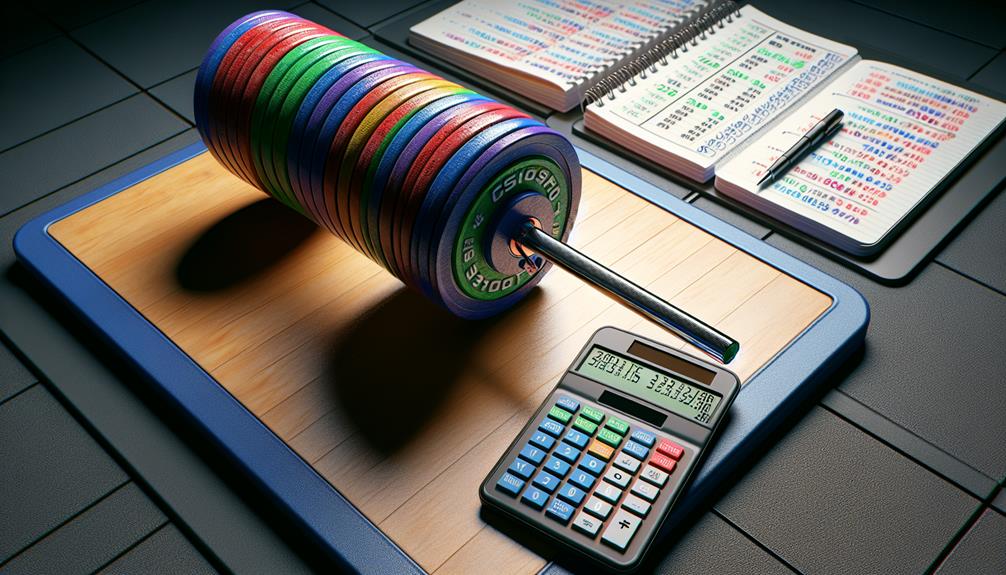One Rep Max Calculator
When it comes to assessing your strength levels, using a One-Rep Max (1RM) calculator is like shining a light on your current fitness capabilities. Have you ever wondered how this tool can provide insights into your overall strength potential? Understanding how to accurately determine your 1RM can be a vital tool in your training arsenal, guiding you towards setting realistic goals and optimizing your workout routines. Ready to uncover the secrets behind this fundamental fitness metric?
Key Takeaways
- Precision in assessing strength levels with 1RM calculator.
- Customized workout plans based on individual strength.
- Setting realistic fitness goals for progress tracking.
- Minimizing injury risk and maximizing gains through accurate training intensity.
Understanding the One-Rep Max Concept
To comprehend the One-Rep Max concept fully, you must grasp the maximum amount of weight you can lift for a single repetition in a given exercise. One key factor in determining your One-Rep Max is form technique. Proper form ensures that you are maximizing the recruitment of the target muscles and reducing the risk of injury. When executing an exercise with correct form, you efficiently engage the muscles intended for that movement, leading to an accurate representation of your true strength capabilities.
Muscle fatigue plays a crucial role in determining your One-Rep Max. As you lift weights, your muscles experience fatigue, which can limit the amount of weight you can lift for a single repetition. Understanding how muscle fatigue affects your performance is essential for accurately calculating your One-Rep Max. By recognizing the point at which muscle fatigue hinders your ability to lift heavier weights safely, you can establish a more precise measurement of your strength levels.
Benefits of Using a 1RM Calculator
Using a 1RM Calculator provides a precise and efficient method for determining your maximum strength levels in various exercises. This tool offers significant benefits in improving performance and enhancing accuracy. By utilizing a 1RM Calculator, you can tailor your workout routines to target specific muscle groups effectively, leading to enhanced overall performance. Additionally, accurately knowing your 1RM allows you to set realistic goals and track progress over time. This level of precision enables you to optimize training intensity and volume, maximizing gains while minimizing the risk of injury. The table below summarizes the key benefits of using a 1RM Calculator:
| Benefits | Description |
|---|---|
| Precision | Accurately determines your maximum strength levels, aiding in setting achievable fitness goals. |
| Efficiency | Provides a quick and reliable method to assess strength, optimizing workout plans for progress. |
| Customization | Allows for tailored exercises based on individual strength levels, enhancing overall performance. |
How to Calculate Your 1RM

For accurate assessment of your maximum strength levels, employ the 1RM calculation method. Calculating your 1RM is crucial in strength assessment and can help tailor your training program effectively. To determine your 1RM, you can use various weightlifting techniques such as the Epley Formula or the Brzycki Formula. The Epley Formula is commonly used and is calculated as follows: 1RM = weight lifted / (1.0278 – 0.0278 × number of repetitions). On the other hand, the Brzycki Formula is calculated as: 1RM = weight lifted × (36 / (37 – number of repetitions)). These formulas provide an estimation of your maximal strength based on the weight lifted and the number of repetitions performed. It is essential to note that these calculations are approximations, and actual 1RM values may vary. By accurately calculating your 1RM using these weightlifting techniques, you can better understand your strength levels and track your progress over time.
Interpreting Your Strength Levels
Moving from determining your 1RM with calculated formulas, the next step involves interpreting your strength levels to gauge your progress accurately. When interpreting your strength levels, consider the following:
- Comparing Benchmarks: Compare your current 1RM values with previous assessments to track improvements over time accurately.
- Strength Standards: Evaluate your 1RM results against established strength standards for your age, gender, and weight category to understand where you stand in terms of strength levels.
- Progress Tracking: Use your interpreted strength levels to set realistic goals and monitor your progress effectively in your strength training journey.
Tips for Progress Tracking

To effectively track your progress in strength training, establish clear benchmarks and regularly assess your performance against them. Progress visualization is a powerful tool for monitoring your advancements. Consider using tools like training journals or apps to visually represent your progress over time. Setting specific, measurable, achievable, relevant, and time-bound (SMART) goals is crucial. When setting goals, ensure they are challenging enough to motivate you but realistic enough to be attainable. Regularly reassess and adjust your goals as you progress to keep yourself engaged and on track.
Consistency is key in progress tracking. Make it a habit to record your workouts, including the exercises performed, weights lifted, and repetitions completed. This data will allow you to analyze trends, identify areas for improvement, and celebrate your successes. By tracking your progress meticulously, you can pinpoint what strategies are working and where adjustments are needed. Remember, progress tracking is not just about the destination but also about the journey and the insights gained along the way.
Frequently Asked Questions
Are There Any Specific Exercises That Are More Accurate in Determining One's 1RM Compared to Others?
When determining 1RM, select exercises that engage multiple muscle groups like squats, deadlifts, or bench presses. These effective lifts provide a comprehensive measurement of strength and are more accurate in assessing your maximal strength levels compared to isolation exercises.
Is It Safe to Attempt a One-Rep Max Lift Without a Spotter or Supervision?
Attempting a one-rep max lift without supervision poses significant risks. Risk assessment is crucial to prevent injuries. Solo lifting, especially with heavy weights, increases the chances of accidents. It's safer to have a spotter to ensure proper form and safety.
Can the 1RM Calculator Be Used for All Age Groups and Fitness Levels?
Yes, the 1RM calculator is versatile and suitable for all age groups and fitness levels. It offers universal applicability with training modifications based on individual capabilities, accommodating age diversity and fitness variations effectively.
How Often Should One Retest Their 1RM to Track Progress Effectively?
To optimize progress tracking effectively, you should retest your 1RM every 4-6 weeks. This frequency allows for accurate assessment of strength gains and adjustments to training programs. Consistent testing is key for monitoring improvements over time.
Are There Any Alternative Methods for Assessing Strength Levels Besides Using a 1RM Calculator?
To assess strength levels beyond a 1RM calculator, consider methods like strength endurance tests measuring how long you can sustain a certain load and relative strength assessments comparing your strength to body weight.
Conclusion
In conclusion, the one-rep max (1RM) calculator is a valuable tool for assessing your strength levels and tracking progress in your fitness journey. By utilizing this methodical approach, you can accurately measure your maximum lifting capacity and set realistic goals for improvement. Stay tuned for more insights on how to optimize your training regimen and continue to push your limits in the pursuit of greater strength and fitness gains.












